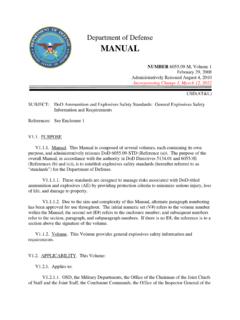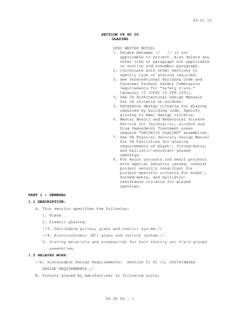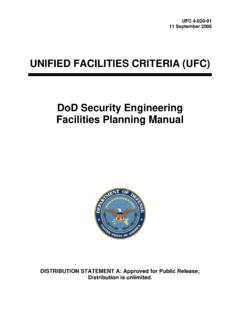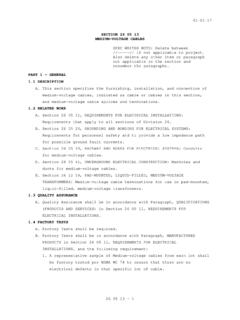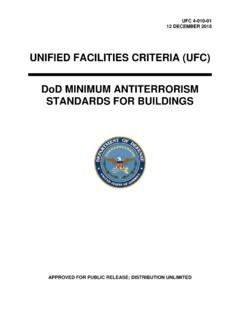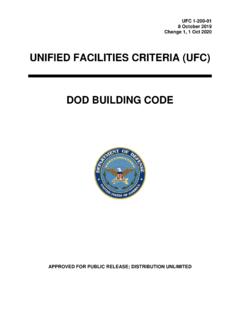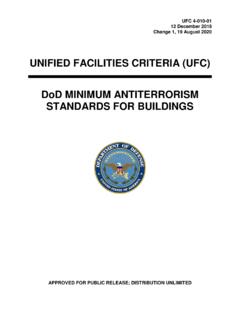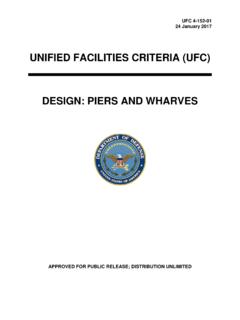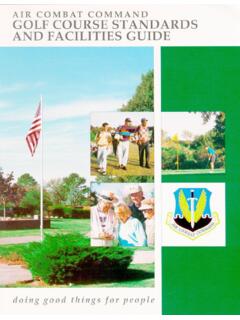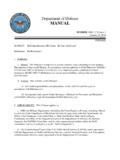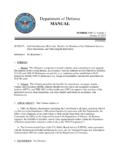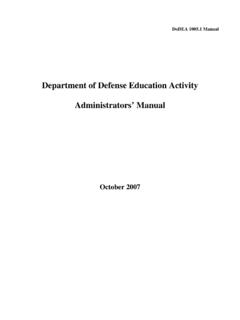Transcription of Department of Defense MANUAL - WBDG
1 Department of Defense MANUAL NUMBER , Volume 5 February 29, 2008 Administratively Reissued August 4, 2010 Incorporating Change 1, September 2, 2011 USD(AT&L) SUBJECT: DoD Ammunition and Explosives Safety Standards: Quantity-Distance Criteria for Intentional Burns or Detonations, Energetic Liquids, and Underground Storage References: See Enclosure 1 PURPOSE MANUAL . This MANUAL is composed of several volumes, each containing its own purpose, and administratively reissues DoD (Reference (a)). The purpose of the overall MANUAL , in accordance with the authority in DoD Directives and (References (b) and (c)), is to establish explosives safety standards (hereafter referred to as standards ) for the Department of Defense . These standards are designed to manage risks associated with DoD-titled ammunition and explosives (AE) by providing protection criteria to minimize serious injury, loss of life, and damage to property. Due to the size and complexity of this MANUAL , alternate paragraph numbering has been approved for use throughout.
2 The initial numeric set (V#) refers to the volume number within the MANUAL ; the second set (E#) refers to the enclosure number; and subsequent numbers refer to the section, paragraph, and subparagraph numbers. If there is no E#, the reference is to a section above the signature of the volume. Volume. This Volume provides quantity-distance (QD) criteria for intentional burning or detonation of AE, storage and operations involving energetic liquids, and underground storage of AE. APPLICABILITY. This Volume: Applies to: DoDM , February 29, 2008 OSD, the Military Departments, the Office of the Chairman of the Joint Chiefs of Staff and the Joint Staff, the Combatant Commands, the Office of the Inspector General of the Department of Defense , the Defense Agencies, the DoD Field Activities, and all other organizational entities within the Department of Defense (hereafter referred to collectively as the DoD Components ). DoD-titled AE wherever it is located.
3 DoD personnel and property when potentially endangered by known host-nation or off-installation AE hazards. DoD facilities siting and construction, except as indicated in paragraph The evaluation of non-DoD explosives siting submissions on DoD installations (see section ). Provided the documentation requirements of paragraph are met, does not apply to: Existing facilities, or those approved for construction under then-current editions of these standards. This exception applies for the balance of the useful lives of such facilities provided: The facility continues to be used for its intended purpose. The explosives safety hazards are not increased. Redesign or modification is not practicable. The quantity of AE cannot be reduced for reasons of operational necessity. Those planned facilities that do not meet these standards, but have been certified by the Heads of the DoD Components (see section ) as essential for operational or other compelling reasons.
4 Other situations that, upon analysis by the Heads of the DoD Components and the Department of Defense Explosives Safety Board (DDESB), are determined to provide the required degree of safety through use of protective construction or other specialized safety features. DEFINITIONS Abbreviations and Acronyms. See Glossary. Change 1, 09/02/2011 2 DoDM , February 29, 2008 Change 1, 09/02/2011 3 Terms. See Volume 8 of this MANUAL . POLICY. As established in Reference (c) and consistent with peacetime, contingency, or wartime operational requirements and corresponding DoD military munitions requirements from the broadest and most fundamental explosives safety management perspective, it is DoD policy to: Provide the maximum possible protection to people and property from the potential damaging effects of DoD military munitions (explosive and chemical). Applying the standards herein provides only the minimum protection criteria for personnel and property, and greater protection should always be provided when practicable.
5 Minimize exposures consistent with safe and efficient operations ( , expose the minimum number of people for the minimum time to the minimum amount of explosives or chemical agents). RESPONSIBILITIES. See Enclosure 2. PROCEDURES. See Enclosures 3 through 5. Criteria provided in this MANUAL are given in English units ( , foot or feet (ft), pounds (lbs), pounds per square inch (psi)), with metric equivalents shown in brackets ( , meters (m), kilograms (kg), kilopascals (kPa)). RELEASABILITY. UNLIMITED. This Volume is approved for public release and is available on the Internet from the DoD Issuances Website at EFFECTIVE DATE. This Volume is effective upon its publication to the DoD Issuances Website. Enclosures 1. References 2. Responsibilities 3. Areas Used for Intentional Burns and Detonations 4. Energetic Liquids 5. Underground Storage of AE Glossary DoDM , February 29, 2008 TABLE OF CONTENTS ENCLOSURE 1: REFERENCES.
6 6 ENCLOSURE 2: RESPONSIBILITIES ..7 UNDER SECRETARY OF Defense FOR ACQUISITION, TECHNOLOGY, AND LOGISTICS (USD(AT&L)) ..7 CHAIRMAN, DDESB ..7 HEADS OF THE DoD COMPONENTS ..7 ENCLOSURE 3: AREAS USED FOR INTENTIONAL BURNS AND DETONATIONS ..8 AREAS FOR BURNING AE ..8 AREAS USED FOR INTENTIONAL DETONATIONS ..8 ENCLOSURE 4: ENERGETIC LIQUIDS ..21 SCOPE AND APPLICATION ..21 CONCEPT ..21 DETERMINATION OF ENERGETIC LIQUIDS QUANTITY ..21 MEASUREMENT OF SEPARATION DISTANCES ..22 HAZARD CLASSIFICATION OF ENERGETIC LIQUIDS ..27 QD STANDARDS ..41 CONTAMINATED ENERGETIC LIQUIDS ..41 ENCLOSURE 5: UNDERGROUND STORAGE OF AE ..42 GENERAL ..42 EXTERNAL QD DETERMINATIONS ..42 GLOSSARY ..58 ABBREVIATIONS AND ACRONYMS ..58 TABLES Default Maximum Case Fragment Distances Versus Diameter for Intentional Detonations.
7 11 Default Maximum Case Fragment Distances Versus Net Explosive Weight (NEW) for Intentional Detonations ..15 Hazard Classifications and Minimum QD For Energetic Liquids ..23 Factors to Use When Converting Energetic Liquid Densities ..26 Energetic Liquid Equivalent Explosive Weights ..31 Change 1, 09/02/2011 CONTENTS 4 DoDM , February 29, 2008 CONTENTS 5 Change 1, 09/02/2011 QD Criteria for OSHA/NFPA Class I-III Flammable and Combustible Energetic Liquids Storage in Detached Buildings or Tanks ..34 QD Criteria for Energetic Liquid Oxidizer (Excluding LO2) Storage in Detached Buildings or Tanks.
8 35 QD Criteria for LO2 Storage in Detached Buildings or Tanks ..37 QD Criteria for LH2 and Bulk Quantities of Hydrazines ..38 Distances to Protect Against Ground Shock ..46 Functions of Loading Density ..47 Debris Dispersal Function ..48 Off-axis Distance Ratios ..52 Values for Ratio, DHYD/VE1 ..53 Values for Ratio, R( )/(DHYD/VE1 ), Without Mitigating FIGURES Dig, Moderately Strong to Strong Rock (w < lb/ft3 [ kg/m3]) ..44 Dig, Moderately Strong to Strong Rock (w > lb/ft3 [ kg/m3]) and Other Materials ..44 Decoupling Factor, fg ..44 Did, Cc < [ ]) ..45 Decoupling Factor, fd ..45 Distance Versus Overpressure Along the Centerline Axis ..50 Distance Versus Overpressure Off the Centerline Axis ..50 Overpressure at IBD ..51 On-axis IBD ..51 DoDM , February 29, 2008 ENCLOSURE 1 REFERENCES (a) DoD , DoD Ammunition and Explosives Safety Standards, February 29, 2008 (cancelled by Volume 1 of this MANUAL ) (b) DoD Directive , Under Secretary of Defense for Acquisition, Technology, and Logistics (USD(AT&L)), December 9, 2005 (c) DoD Directive , Explosives Safety Management and the DoD Explosives Safety Board, August 19, 2005 (d) Department of Defense Explosives Safety Board, Technical Paper 16, Methodologies for Calculating Primary Fragment Characteristics, April 1, 20091 (e) Part of title 29, Code of Federal Regulations (f) National Fire Protection Association 30, Flammable and Combustible Liquids Code, current version2 (g) National Fire Protection Association 430, Code for the Storage of Liquid and Solid Oxidizers, current version2 (h) Parts 171-177 of title 49, Code of Federal Regulations, current edition (i)
9 Army Technical Bulletin 700-2, Naval Sea Systems Command Instruction , Technical Order 11A-1-47, Defense Logistics Agency Regulations , Department of Defense Ammunition and Explosives Hazard Classification Procedures, January 5, 19981 (j) American Society of Mechanical Engineers, Boiler and Pressure Vessel Code, Section VIII, Rules for Construction of Pressure Vessels, Division 1/Division 2, current version3 (k) Wilton, C., Investigation of the Explosive Potential of the Hybrid Propellant Combinations N2O4/PBAN and CTF/PBAN, AFRPL-TR-67-124, 1967 (AD A003 595)4 (l) National Fire Protection Association 251, Standard Methods of Tests of Fire Resistance of Building Construction and Materials, current version2 (m) National Fire Protection Association 50, Standard for Bulk Oxygen Systems at Consumer Sites, current version2 (n) Zabetakis, M. G. and Burgess, D. S., Research on the Hazards Associated With the Production and Handling of Liquid Hydrogen, Department of the Interior, Bureau of Mines Report 5707, 19615 1 Available from DDESB, Room 856C, Hoffman Building I, 2461 Eisenhower Avenue, Alexandria, VA 22331-0600; Phone: 703-325-0891; Fax: 703-325-6227 2 NFPA, 1 Batterymarch Park, Quincy, MA 02169-7471; Phone: 617-770-3000; Fax: 617-770-0700 3 ASME International, 22 Law Drive, Box 2900, Fairfield, NJ 07007-2900; Phone: 800-843-2763; International: 973-882-1167; Fax: 973-882-1717 4 Defense Technical Information Center, Fort Belvoir, VA; Phone: 800-225-3842 5 Chemical Propulsion Information Agency (CPIA) Accession Number 1964-0291, CPIA, The Johns Hopkins University, 10630 Little Patuxent Parkway, Suite 202, Columbia, MD 21044-3204; Phone: 410-992-7300.
10 Fax: 410-730-4969 Change 1, 09/02/2011 ENCLOSURE 1 6 DoDM , February 29, 2008 ENCLOSURE 2 RESPONSIBILITIES UNDER SECRETARY OF Defense FOR ACQUISITION, TECHNOLOGY, AND LOGISTICS (USD(AT&L)). The USD(AT&L) shall provide overall policy guidance for the DoD Explosives Safety Management Program. CHAIRMAN, DDESB. The Chairman, DDESB, shall report to the Deputy Under Secretary of Defense for Installations and Environment (DUSD(I&E)) and, on behalf of the USD(AT&L) and the DUSD(I&E), shall collaborate with the Military Service-appointed voting DDESB members to maintain explosives safety standards. HEADS OF THE DoD COMPONENTS. The Heads of the DoD Components shall: Implement these DoD explosives safety standards. Comply with applicable Federal and State laws and regulations. Where this Volume conflicts with such laws and regulations, ensure the safety of DoD personnel and the public while complying and notify the Chairman, DDESB, through the Component s board member, of the conflict.
